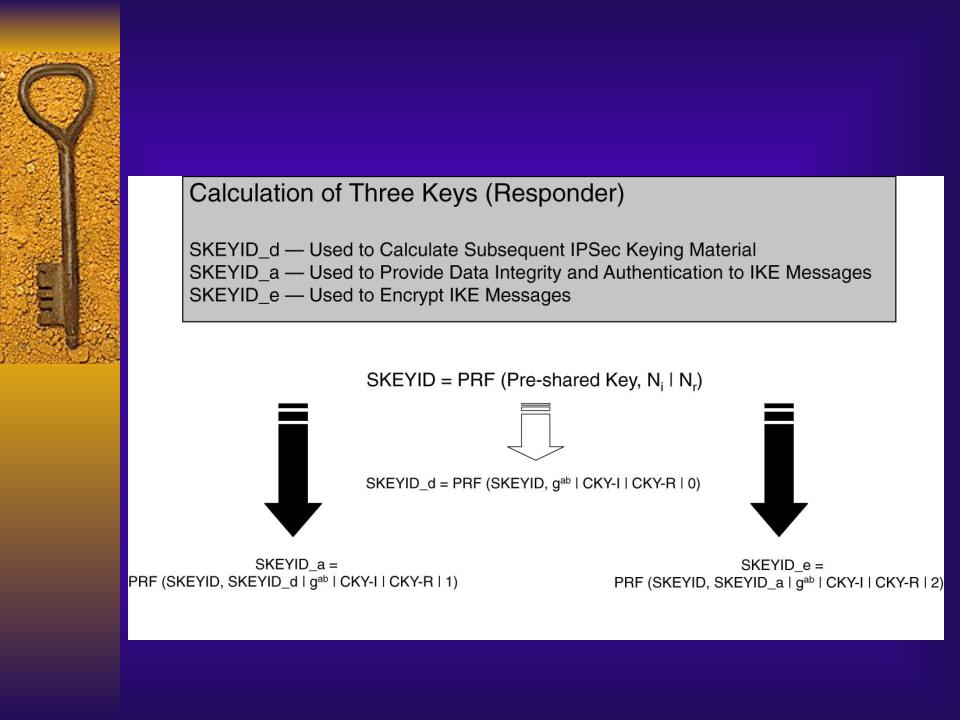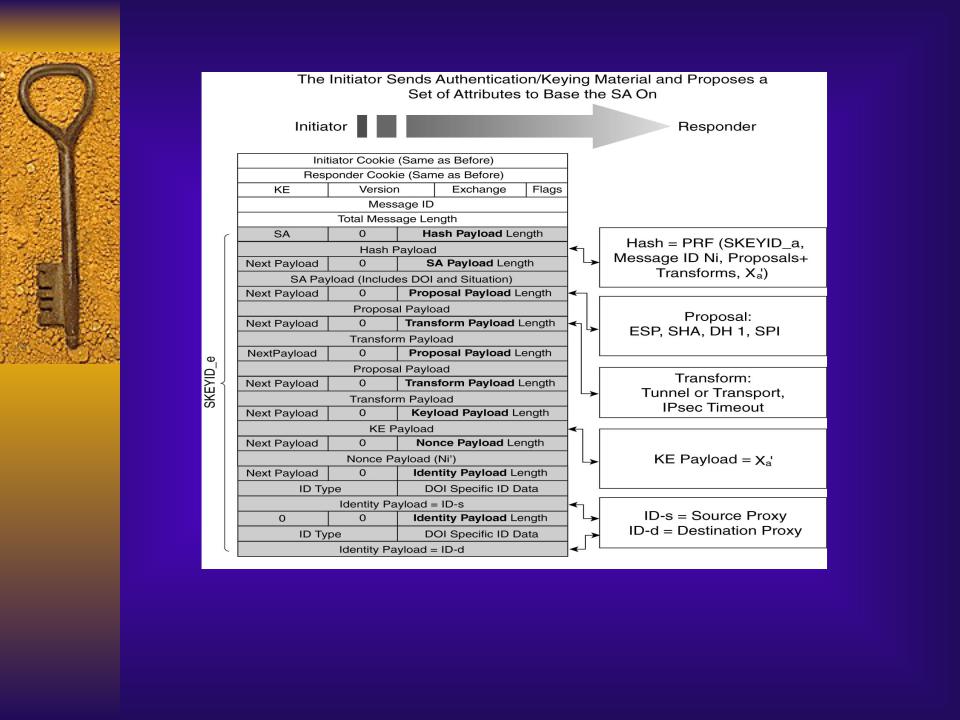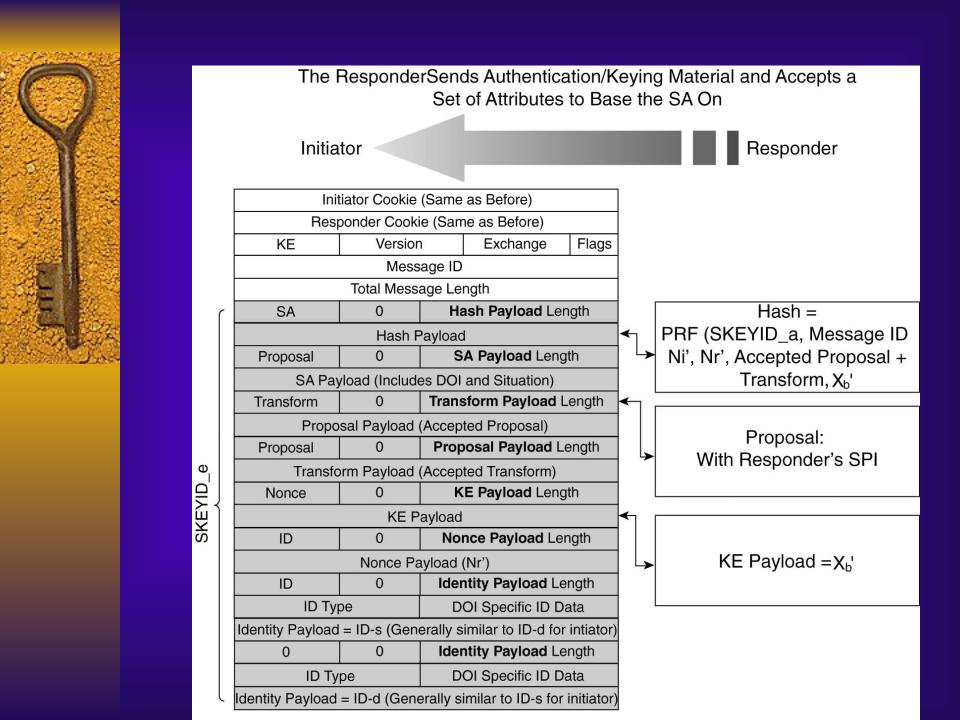
- •Chapter 13 IPsec
- •IPsec (IP Security)
- •Types of IPsec VPNs
- •LAN-to-LAN and Site-to-Site
- •Remote-Access IPsec
- •IPsec Protocol Suite
- •IKE’s Responsibilities
- •Composition of IKE
- •IPsec Tunnel Creation
- •IKE Main Mode, Aggressive
- •Goals of Main Mode and
- •Types of Negotiations by IKE
- •Goals of Quick Mode
- •IKE Main Mode Message 1
- •IKE Main Mode Message 2
- •Diffie-Hellman Algorithm
- •Diffie-Hellman Algorithm (cont.)
- •IKE Main Mode Message 3
- •IKE Main Mode Message 4
- •Session Keys Generated by the Initiator
- •Session Keys Generated
- •IKE Main Mode Message 5
- •IKE Main Mode Message 6
- •Completion of IKE Phase I (Main Mode) using Preshared Key
- •IKE Phase 2 (Quick Mode)
- •IKE Quick Mode Message 1
- •IKE and IPsec Lifetime
- •IKE Quick Mode Message 2
- •Generation of IPsec
- •IKE Quick Mode Message 3
- •Main Mode Using
- •Session Keys Generated
- •Session Keys Generated
- •IKE Main Mode Message 5
- •IKE Main Mode Message 6
- •Aggressive Mode of IKE Phase 1 using Preshared Key Authentication
- •IKE Aggressive Mode Message 1
- •IKE Aggressive Mode Message 2
- •IKE Aggressive Mode Message 3
- •IKE Device Authentication
- •Contents of a Digital Certificate
- •Using Digital Certificates
- •IKE Main Mode Using
- •Encryption Methods in IPsec
- •DES Encryption using
- •3DES Encryption
- •Integrity Checking Mechanism
- •Integrity Checking Using Hashes
- •Use of Hashes in ESP and AH
- •Packet Encapsulation in IPsec
- •Packet Format Using AH in
- •Packet Format Using ESP in
- •ESP Header Format
- •AH Header Format
- •IKE Enhancements for Remote-Access Client IPsec
- •Extended Authentication and
- •Negotiation of X-Auth During
- •Start of X-Auth with Exchange of Attribute Payloads Using ISAKMP Messages
- •Completion of X-Auth with Exchange of Attribute Payloads Using ISAKMP
- •Mode Configuration During
- •Exchanging Attribute Payloads Between
- •NAT Transparency
- •Tagging on a UDP Header to Traverse PAT

Session Keys Generated
by the Responder

IKE Main Mode Message 5
-Hash payload and ID_I are used by responder to authenticate initiator -Identity and hash payloads are encrypted using skeyid_e

IKE Main Mode Message 6
-Hash payload and ID_R are used by initiator to authenticate responder -Identity and hash payloads are encrypted using skeyid_e

Completion of IKE Phase I (Main Mode) using Preshared Key
IKE SA established
Main mode using preshared key authentication completed
Quick mode will be used to negotiate parameters of IPsec SA

IKE Phase 2 (Quick Mode)
Negotiate parameters of IPsec SA
Perfect Forward Secrecy (PFS) may be used by initiator to request that a new DH secret be generated over an encrypted channel
–New nonces generated: Ni` and Nr`
–New DH public values:
•Xa`=ga mod p
•Xb`=gb mod p

IKE Quick Mode Message 1
-Hash used for reauthentication
-proposal and transform suggests ESP or AH encapsulation type,
SHA or MD5 integrity checking, DH group, and tunnel or transport mode - Key exchange payload used for generating new DH secret

IKE and IPsec Lifetime
Negotiation

IKE Quick Mode Message 2

Generation of IPsec
Keying Material
Both peers generate new DH shared secret = (Xb`)a mod p = (Xa`)b mod p
Both peers generate shared session keys for incoming and outgoing IPsec SAs based on SKEYID_d, new DH shared secret, SPI, and Ni` and Nr`

